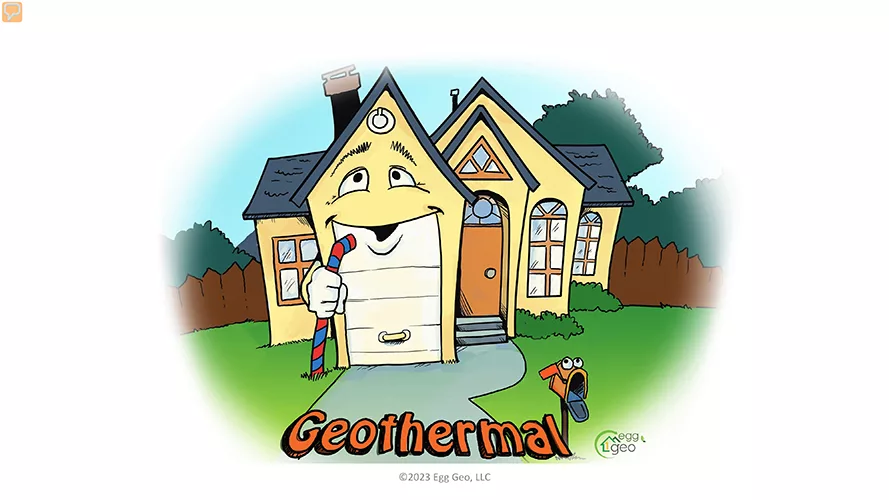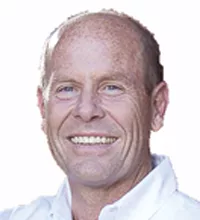By Jay Egg and Kristy Egg
There are many references to the beginning of the geothermal heat pump industry. The version rising to the top involves the founders of WaterFurnace International.
David Hatherton’s father was a water well driller in Ontario, Canada. On a cold 1968 winter day in Ontario, Hatherton was onsite with his dad. During the initial pumping of a water well, Hatherton’s hands were very cold; his dad suggested he stick his hands in the well water, and he noticed that it was warm. Really, it was about 50 degrees, but it was so much warmer than the icy outside temperatures. It clicked that there was thermal energy in the ground, an unlimited resource.
Ten years later, he stumbled upon a water-source heat pump at a water well convention in Oklahoma City displayed by David Hart (founder of TETCO and a true geo pioneer). A tank was filled with cold water; the heat pump pulled heat from the water and expelled warm air. It was an epiphany and set the path for the next 40-plus years.
Hatherton’s father passed away in 1980. He decided to use the skills he had learned to put together a water-source heat pump that he tied into one of the water wells on his property. It worked.
Shortly after that experiment, in 1980, Hatherton and two friends came up with the name WaterFurnace (as in getting heat from water) for the product. The name was trademarked in Ontario, Canada, and in the United States a year later.
The choice of the name WaterFurnace did not sit well with everyone in Hatherton’s circle. He suggested they come up with something that better described the product. They did, and the world embraced it. The name tells the story of the water-source heat pump. Instead of a furnace that combusted some type of fossil fuel, the WaterFurnace heat pump used the energy from water in the earth to provide heat.

Two years earlier, in Indiana, Dan Ellis was in the business of improving efficiency and conserving oil and energy. In 1978, he started a company called Genesis Energy Systems. His idea involved a water-source heat pump with a solar-thermal boost, as can be seen in the article that ran in 1982 about that system in an HVAC trade publication.
Hatherton read the article, then he traveled to Fort Wayne, Indiana, to meet Ellis. They had dinner with Harmon Hensley, president of Hattersley and Sons in Fort Wayne — a man of means who had caught hold of what they wanted to do.
The late Dr. Jim Bose of Oklahoma State University (OSU) started working with Dr. Jim Partin (GeoSystems) and Gerald Parker on geothermal closed-loop science, coming up with the first equations for piped heat transfer in a horizontal closed-loop exchanger. Bose eventually organized the OSU-housed International Ground Source Heat Pump Association (IGSHPA; www.igshpa.org) in 1987. Ellis and Hatherton attended the inaugural meeting of IGSHPA.
Checking the date on Hatherton’s certificate for the successful completion of the closed-loop, earth-coupled heat-pump workshop, one can see that it was signed by Dr. Jim Bose, and it gives an idea of what an early adopter Hatherton was. The date on the certificate is Feb. 24, 1983, and IGSHPA was organized at OSU four years later, in 1987, with Bose as executive director.
WaterFurnace Manufacturing and Sales
In 1983, Ellis, Hatherton and Harmon formed WaterFurnace International and became the prime distributor for Command Aire, private labeling the product with the WaterFurnace label. A year later, they attempted to acquire Command Aire. When the Command Aire part of the deal failed, Ellis arranged for the purchase of McQuay’s water source division with the help of investors, which bootstrapped WaterFurnace fully into the manufacturing business in 1985.
In the images of Hatherton and Ellis in front of the first WaterFurnace booth in that warehouse, you can see the harvest-gold carpet, popular in decorating of that age.
Since Hatherton was a Canadian citizen and was moving his family to Fort Wayne in 1984, Ellis wrote a letter to get Hatherton a green card to come to the United States and work as the executive vice president of WaterFurnace.
In 1983, Hatherton’s Ontario distribution company had purchased $500,000 worth of WaterFurnace equipment (worth more than $1.5 million today) and was the largest distributor in North America. By January 1984, WaterFurnace had set up perhaps 20 distributors, enlisted the support of electrical co-ops (local electric companies) to monetize geothermal heat pump rebates in their areas, and had completed commercial projects involving hundreds of vertical boreholes and fields.
During the early 1980s, the Carter administration still had federal tax credits on the rolls for heat pumps, but those were eliminated by the new administration in 1984. Despite that, WaterFurnace sold $2.2 million in geothermal heat pumps by the end of 1984, showing a $200,000 profit.

While Ellis was physically building up geothermal heat pump production, Hatherton was working hard with various energy utilities to ensure ground-source heat pumps got the attention they needed in the form of demand-side management incentives.
Hatherton’s line has always been that the “earth loop” was a magic transformer that every utility should have on the grid, and energy averted by the installation of a geothermal heat pump (GHP) was worth at least three times the cost of the incentives in demand-side reduction to the electric utilities. That is true now more than ever.
Ellis went on to run WaterFurnace from 1983 through 1995, bringing the company to a status atop the geothermal heat pump industry that is still seen today.
The Growth of Geothermal Organizations
During Hatherton’s years in Washington, he worked closely with the late John Hoffman at the U.S. Environmental Protection Agency. Hoffman was a key contributor to the Montreal Protocol, whose work helped to reverse the effects of CFCs, which had been depleting the ozone layer of the earth’s atmosphere.
In 1995, Ellis took a position as president of the fledgling ClimateMaster geothermal heat pump line. At the time, ClimateMaster was substantially in debt and not profitable. John Bailey was Ellis’ second in command and provided much of the marketing and technical support that launched the brand to a high status in geothermal heat pumps.
By the time Ellis left ClimateMaster in 2015, it was showing sales of over $200 million per year and substantial profitability, according to Hatherton.
In 1989, the Canadian Earth Energy Association (CEEA; www.cangea.ca) and Ontario Hydro developed the Canadian Standards Association (www.csagroup.org); these standards are still in effect today throughout North America.
These standards were created for specifications and the basis for training to enable the installation of 7,300 units in Ontario in three years. WaterFurnace engaged the CEEA to launch a GSHP-focused organization in Washington, D.C. — the Earth Energy Association — and hired a part-time employee. This helped to build the foundation for the Geothermal Exchange Organization (GEO; www.geoexchange.org).
In 1993, Ellis sent Hatherton to Washington with the mission to launch the GSHP Consortium and meet with various organizations: the EPA, the U.S. Department of Energy, the Electric Power Research Institute, the National Rural Electric Cooperative Association and the Edison Electric Institute (EEI). “Space Conditioning: The Next Frontier” was a result of this effort during Hoffman’s EPA tenure (https://bit.ly/43FfFsE).
Addressing Climate Change
The Climate Change Action Plan (created during the Clinton/Gore administration) was a key opportunity to have GSHPs recognized (https://bit.ly/3MRqfq0). The EEI was an ally that provided office, meeting space and connections with investor-owned utilities. Mike McGrath (EEI) and Lou Pratch (DOE), and lawyers Mike Kraft and Ted Bristol made connections with former U.S. Rep. John Meyers from Indiana and former U.S. Secretary of Energy Hazel O’Leary.
Coincidentally, Ellis and Bailey happened to meet with Congressman Meyers on a flight to Indianapolis and chatted with him about WaterFurnace and the message in Washington. This made an impression on Meyers and helped open the doors at DOE/Congress. Hatherton said, “Congressman Meyers is a serious man who cared deeply about America.” He didn’t recall any adversarial politics when working with Meyers.
Hatherton’s team put together the National Earth Comfort Program, the most in-depth business plan to that date, laying out the rationale for moving forward with GSHPs. The National Earth Comfort Program and the EPA’s “Space Conditioning: The Next Frontier” were instrumental in making the case for GSHPs.
The DOE agreed to help by funding one-third of the proposed $100 million for the GSHP rollout if the utility industry agreed to fund two-thirds ($66.3 million dollars). EEI was the key player in convincing its member utilities to co-fund this proposal, and this launched the Geothermal Heat Pump Consortium (GHPC; now GEO).
In 2007, Bosch Thermotechnology, through its purchase of Florida Heat Pump, entered the geothermal heat pump manufacturing effort. In 2017, Dandelion, a Google X spin-out, entered the market and began to manufacture its own brand of geothermal heat pumps.
Now, organizations such as Home Energy Efficiency Team (HEET, www.heet.org) in Massachusetts have exposed more of the dangers of methane. Since 2008, HEET has made the industry much stronger through its support of legislation and implementation of an open protocol for thermal energy networks and community heat pump systems. HEET’s academic prowess and strong science backbone have created a truly valuable resource for the industry.
Similarly, Texas newcomer Project Innerspace (www.projectinnerspace.org) and founder Jamie Beard are getting serious traction in the geothermal industry through their efforts, co-winning the DOE’s $165 million GEODE award with Geothermal Rising and SPE Geothermal (https://bit.ly/3ouoln3).
In 2015, at the Long Island Geothermal Conference, the authors at Egg Geo met many of the folks who would go on to become the charter board members for the New York Geothermal Energy Organization (NY-GEO, www.ny-geo.org), the largest and most successful state-based organization for geothermal implementation in the country at this time.
One of the associates for the NY-GEO and Long Island Geothermal Association was a visionary named Donovan Gordon. He applied and was hired for the newly created position of director at the New York State Energy Research and Development Authority’s (NYSERDA, www.nyserda.ny.gov) Clean Heating and Cooling division, where he remains to this day.

Gordon has been instrumental in a metamorphosis in the industry, where we have gone from focusing on single heat-pump installations to focusing on community heat-pump installations, a trend which has caught hold at the federal level with the latest round of community heat-pump awards being issued by the DOE in spring 2023.
Bringing Geothermal Enthusiasts Together
Presently, the NY-GEO conference, the IGSHPA conference, and the Geothermal Rising (GR, https://bit.ly/3OH6iEP) are the three largest geothermal heat pump conferences in the United States, drawing approximately 600 or 700 in attendance for the first two, and closer to 2000 in attendance for Geothermal Rising.
At the GR conference last year, four U.S. senators addressed the members in attendance. Ryan Dougherty, executive director at the Geothermal Energy Organization (GEO), attended the plenary session and did a remarkable job of bringing the geothermal industry together. In June 2023, Bryant Jones, executive director at Geothermal Rising, traveled to Albany for the NY-GEO Conference and moved the needle further toward harmonizing the industry.
In 2018, after a discussion with Ellis and Steve Smith, president of Enertech, talking about the 50 to 60 percent decline in business with the demise of the tax credits, Hatherton arranged to meet with Gerteric Lindquist, CEO of NIBE.
During that economic downturn, GEO was running out of money and was unable to continue its Washington efforts. Hatherton asked Lindquist if he could have NIBE invest in GEO so that the lobbying efforts could be continued in Washington to reinstate the geothermal tax credits. NIBE did it! GEO worked tirelessly in DC, and the tax credits were reinstated. This was worth billions of dollars to the entire industry and the end-use consumers.
In Canada, Hatherton worked with the Ontario Geothermal Association (www.ontariogeothermal.ca), the Heating, Refrigeration and Air Conditioning Institute of Canada (www.hrai.ca) and a team of volunteers to enable the geothermal users to receive Eco Energy support of up to a $14,000 per GSHP rebate. While the program was successfully launched in 2017-2018, a new conservative government canceled the program after only five months.
Presently, a new rebate system is in the works in Quebec where Hatherton contributed as an advisor. The rebate is set at $750 per thousand BTUs in Quebec. Based on these figures, the average home will receive about $27,000 in funding.
As with any multiverse, several other players have come along the way and contributed greatly to this industry. There are so many we have not named in this short history of geothermal heat pumps in North America.
Please support the geothermal industry and the organizations mentioned here. We serve legislators, professionals, tradespeople and consumers and aid in the final frontier of decarbonization and building electrification with geothermal technologies. The geothermal industry provides cooling, heating, domestic hot water and electrical needs for our cities and communities. And we’ve only just begun.
Special thanks to David Hatherton, Dan Ellis and countless others for contributing and reviewing for accuracy!







